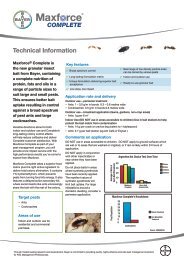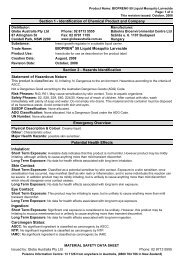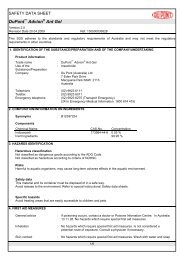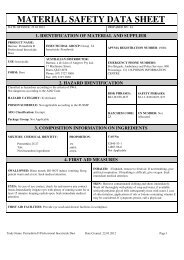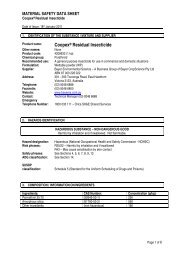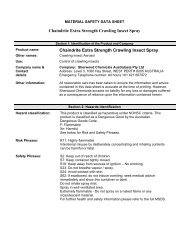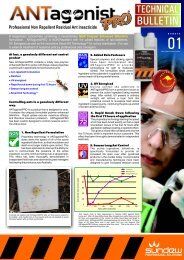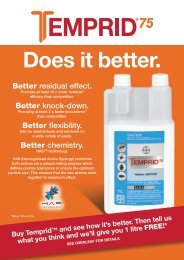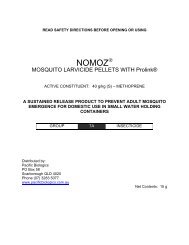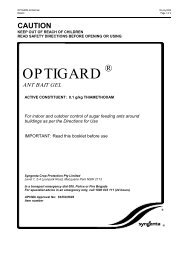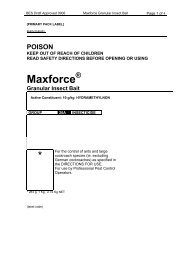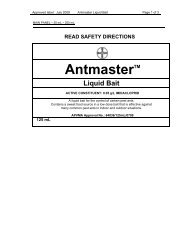Biflex AquaMax MSDS - Globe Australia
Biflex AquaMax MSDS - Globe Australia
Biflex AquaMax MSDS - Globe Australia
You also want an ePaper? Increase the reach of your titles
YUMPU automatically turns print PDFs into web optimized ePapers that Google loves.
MATERIAL SAFETY DATA SHEET<br />
Page 1 of Total 5<br />
Date of Issue: May 2007<br />
<strong>MSDS</strong> No. FMC/AQUAMAX/2<br />
SECTION 1<br />
IDENTIFICATION OF THE MATERIAL AND SUPPLIER<br />
Product Name:<br />
BIFLEX ® AQUAMAX 100 SC INSECTICIDE<br />
Other Names: Bifenthrin.<br />
Use:<br />
Termiticide and insecticide in buildings and other structures.<br />
Company:<br />
FMC Australasia Pty Ltd.<br />
Address: Unit 26, 8 Metroplex Ave, Murarrie, Qld 4172<br />
Telephone Number: 07 3908 9222 Fax Number: 07 3908 9221<br />
Emergency Telephone Number: 1800 033 111 (All hours - <strong>Australia</strong> wide).<br />
SECTION 2<br />
HAZARDS IDENTIFICATION<br />
Classified as hazardous according to criteria of NOHSC <strong>Australia</strong>.<br />
Not classified as a Dangerous Good according to the ADG Code.<br />
Risk phrases:<br />
R20/22 Harmful by inhalation and if swallowed<br />
Safety Phrases: S2 Keep out of reach of children.<br />
S13 Keep away from food, drink and animal feeding stuffs.<br />
S23 Do not breathe vapour or spray.<br />
S36/37 Wear suitable protective clothing and gloves.<br />
S39 Wear eye/face protection.<br />
SECTION 3<br />
COMPOSITION/INFORMATION ON INGREDIENTS<br />
Ingredients:<br />
CHEMICAL CAS NUMBER PROPORTION<br />
Bifenthrin 82657-04-3 100 g/L<br />
Other ingredients determined not to be hazardous mixture Balance<br />
SECTION 4<br />
FIRST AID MEASURES<br />
FIRST AID<br />
Swallowed: If poisoning occurs, contact a doctor or Poisons Information Centre. Phone<br />
<strong>Australia</strong> (13 11 26). If any discomfort persists seek medical advice.<br />
Eye: If in eyes, hold eyes open and flush with water for at least 15 minutes. If<br />
irritation occurs and persists, obtain medical attention.<br />
Skin: If on skin wash with plenty of soap and water. Remove contaminated clothing.<br />
If irritation occurs and persists see a doctor.<br />
Inhaled: Remove patient to fresh air. If breathing discomfort occurs, obtain medical<br />
attention.<br />
Advice to Doctors: Bifenthrin the active ingredient in this product is a pyrethroid insecticide.<br />
Treatment is otherwise symptomatic and supportive.
Product Name:<br />
SECTION 5<br />
BIFLEX AQUAMAX 100 SC<br />
Insecticide<br />
FIRE FIGHTING MEASURES<br />
Page 2 of Total 5<br />
Issued: May 2007<br />
FMC/AQUAMAX/2<br />
Specific Hazard: Product is a not flammable.<br />
Extinguishing media: Foam, CO 2 or dry chemical. Soft stream water fog if no alternatives.<br />
Contain all runoff.<br />
Hazards from combustion products: On burning will emit toxic fumes of carbon monoxide,<br />
carbon dioxide, hydrogen chloride, chlorine, fluorine and hydrogen fluoride etc.<br />
Precautions for fire-fighters and special protective equipment: Isolate fire area.<br />
Evacuate downwind. Wear full protective clothing and self-contained breathing apparatus. Do<br />
not breathe or contact smoke, gases or vapours generated.<br />
SECTION 6<br />
ACCIDENTAL RELEASE MEASURES<br />
Emergency procedures: Isolate and post spill area. Keep out unprotected persons and<br />
animals. Wear prescribed protective clothing and equipment.<br />
Spills: In the case of spillage, contain and absorb spilled material with absorbent material<br />
such as sand, clay or cat litter and dispose of waste according to the <strong>Australia</strong>n Standard<br />
2507 - Storage and Handling of Pesticides. Keep material out of streams and sewers.<br />
Vacuum, shovel or pump waste into an approved drum. Label for contents. Dispose of<br />
drummed wastes, including decontamination solution, in accordance with the requirements of<br />
Local or State Waste Management Authorities.<br />
Material and methods for containment and cleanup procedures: To clean spill area, tools<br />
and equipment, wash with a solution of soap, water and acetic acid/vinegar. Follow this with a<br />
neutralisation step of washing the area with a bleach or caustic soda ash solution. Finally,<br />
wash with a strong soap and water solution. Absorb, as above, any excess liquid and add<br />
both solutions to the drums of waste already collected.<br />
Do NOT allow spilled product or wash solution to enter sewers, drains, dams, creeks or any<br />
other waterways.<br />
SECTION 7<br />
HANDLING AND STORAGE<br />
Precautions for Safe Handling: Ensure containers are kept closed until using product. Avoid<br />
skin and eye contact and breathing vapour. When opening the container and preparing spray,<br />
wear cotton overalls buttoned to the neck and wrist (or equivalent clothing), elbow length<br />
nitrile gloves and face shield or goggles. When using the prepared spray, wear cotton overalls<br />
buttoned to the neck and wrist (or equivalent clothing) and elbow length nitrile gloves.<br />
Conditions for Safe Storage: DO NOT store near (or allow to contact) fertilizers, fungicides<br />
or pesticides. Store in the closed original container, in a cool well ventilated area, out of direct<br />
sunlight. Store in a locked room or place away from children, animals, food, feed stuffs, seed<br />
and fertilizers.<br />
SECTION 8<br />
EXPOSURE CONTROLS / PERSONAL PROTECTION<br />
National Exposure Standards:<br />
No exposure standard for bifenthrin has been established by NOHSC <strong>Australia</strong>. However, the<br />
following exposure standard has been established:<br />
Atmospheric Contaminant Exposure Standard (TWA) a Proportion in <strong>AquaMax</strong><br />
Propane-1,2-diol total: (vapour &<br />
150 ppm (474 mg/m³) < 5%<br />
particulates)<br />
TWA = Time-weight Average
Product Name:<br />
BIFLEX AQUAMAX 100 SC<br />
Insecticide<br />
Page 3 of Total 5<br />
Issued: May 2007<br />
FMC/AQUAMAX/2<br />
It is highly unlikely that atmospheric concentrations of Propane-1,2-diol will reach the above<br />
concentrations when used as directed.<br />
Biological Limit Values:<br />
No biological limit allocated.<br />
Engineering controls:<br />
Use in well ventilated area only. Use local exhaust at all process locations where spray may be<br />
emitted. Ventilate all transport vehicles prior to unloading. Keep containers closed when not in<br />
use.<br />
Personal Protective equipment (PPE):<br />
Work Clothing: Wear cotton overalls buttoned to the neck and wrist and a washable hat, elbowlength<br />
PVC or nitrile gloves and face shield or goggles.<br />
Eye Protection: When using product, wear chemical protective goggles or face shield.<br />
Respiratory Protection: If inhalation risk exists, wear a properly fitted half-face or full-face airpurifying<br />
respirator which is approved for pesticides (<strong>Australia</strong>n Standards).<br />
Gloves: Wear chemical protective gloves made of materials such as nitrile, Viton ® brand or PVC<br />
when handling this product. Inspect regularly for leaks. Wash the outside of gloves with soap and<br />
water prior to removal.<br />
Personal Hygiene: Clean water should be available for washing in case of eye or skin<br />
contamination. Wash skin before eating, drinking or smoking. Shower at the end of the workday.<br />
SECTION 9<br />
PHYSICAL AND CHEMICAL PROPERTIES<br />
Appearance:<br />
Odour:<br />
Boiling point:<br />
Freezing point:<br />
Specific Gravity:<br />
pH:<br />
Solubility in Water:<br />
Flammability:<br />
Corrosive hazard:<br />
White, opaque liquid.<br />
Very mild, soap like odour.<br />
Not available.<br />
Not available.<br />
1.02 g/mL.<br />
Not available.<br />
Product suspends in water.<br />
Not flammable.<br />
Non corrosive; compatible with stainless steel containers &<br />
polyethylene used in spray tanks and parts.<br />
Not applicable, not flammable..<br />
Flashpoint (°C) :<br />
Flammability Limits (%): Not flammable.<br />
Poisons Schedule: Product is a schedule 6 poison.<br />
SECTION 10<br />
STABILITY AND REACTIVITY<br />
Chemical Stability: Product is considered stable in ambient conditions for a period of at least<br />
2 years after manufacture.<br />
Conditions to avoid: No particular conditions to avoid.<br />
Incompatible materials: No particular materials to avoid.<br />
Hazardous decomposition products: When the product is heated to high temperatures, the<br />
active constituent will decompose and emit toxic fumes.<br />
Hazardous reactions: No particular reactions to avoid.<br />
SECTION 11<br />
TOXICOLOGICAL INFORMATION<br />
Potential Health Effects:<br />
Studies with laboratory animals have shown this product to be harmful if swallowed. Ingestion of<br />
large doses of bifenthrin by laboratory animals produced signs of toxicity which included clonic<br />
convulsions, tremors and bloody nasal discharge. Irritating to eyes and respiratory system.
Product Name:<br />
BIFLEX AQUAMAX 100 SC<br />
Insecticide<br />
Page 4 of Total 5<br />
Issued: May 2007<br />
FMC/AQUAMAX/2<br />
Acute<br />
Swallowed: This product is harmful if swallowed; the acute oral LD 50 (rat) = 505 mg/kg<br />
(calculated).<br />
Eye: Not irritating.<br />
Skin:<br />
Inhaled:<br />
This product has a low dermal toxicity. The dermal LD 50 (rabbit) > 2000 mg/kg.<br />
Skin sensitising may occur in sensitive individuals.<br />
This product is harmful if inhaled. Acute inhalation LC 50 = 8.7 mg/L/4 hour<br />
(calculated).<br />
Chronic: No data available on this formulation. In studies with laboratory animals, Bifenthrin<br />
Technical did not cause teratogenicity or reproductive toxicity. Tremors were associated with<br />
repeated exposure of dogs, rats, rabbits and mice to Bifenthrin. The overall results from a<br />
battery of genotoxicity studies indicate that Bifenthrin is not considered to be genotoxic. Ames<br />
test results were negative.<br />
SECTION 12<br />
ECOLOGICAL INFORMATION<br />
Environmental Toxicology: The active ingredient, Bifenthrin, is highly toxic to fish and aquatic<br />
arthropods with LC 50 values ranging from 0.0038 µg/L to 17.8 µg/L. In general, the aquatic<br />
arthropods are the most sensitive species. Care should be taken to avoid contamination of the<br />
aquatic environment. Bifenthrin had no effect on molluscs at its limit of water solubility. Bifenthrin<br />
is only slightly toxic to both waterfowl and upland game birds with LC 50 values range from 1800<br />
mg/kg to > 2,150 mg/kg. Do not contaminate sewers, drains, dams, creeks or any other<br />
waterways with product or the used container.<br />
Environmental Properties: The active ingredient, Bifenthrin, degrades at a moderate rate in<br />
agricultural soils (t½ = 50 to 205 days), and more rapidly on the surface of bare soils (t½ = 7 to<br />
62 days). Bifenthrin is tightly bound in most soils and has extremely low water solubility.<br />
SECTION 13<br />
DISPOSAL CONSIDERATIONS<br />
Disposal: Label all recovered material for contents. Dispose of drummed wastes, including<br />
decontamination solution, in accordance with the requirements of Local or State Waste<br />
Management Authorities.<br />
Dangerous to Fish: Do NOT allow spilled product or wash solution to enter sewers, drains, dams,<br />
creeks or any other waterways.<br />
Disposal of empty, non-returnable containers: Triple or preferably pressure rinse<br />
containers before disposal. Add rinsings to spray tank. Do not dispose of undiluted chemicals<br />
on-site. If recycling, replace cap and return containers to recycler or designated collection<br />
point. If not recycling, break, crush or puncture and bury empty containers in a local authority<br />
landfill. If not available bury the containers below 500 mm in a disposal pit specifically marked<br />
and set up for this purpose clear of waterways, vegetation and roots. Empty containers and<br />
product should not be burnt.<br />
SECTION 14<br />
TRANSPORT INFORMATION<br />
Road & Rail Transport: <strong>Biflex</strong> <strong>AquaMax</strong> 100 SC is not classified as a Dangerous Goods under<br />
the <strong>Australia</strong>n Code for the Transport of Dangerous Goods by Road and Rail.
Product Name:<br />
BIFLEX AQUAMAX 100 SC<br />
Insecticide<br />
Page 5 of Total 5<br />
Issued: May 2007<br />
FMC/AQUAMAX/2<br />
Marine and Air Transport: Product is a Marine Pollutant according to International Maritime<br />
Dangerous Goods (IMDG) Code and the International Air Transport Association (IATA). If<br />
transporting by sea or air the following Dangerous Goods Classification applies:-<br />
UN 3082, Class 9 (Miscellaneous Dangerous Goods), Packing Group III, Proper Shipping<br />
Name ENVIRONMENTALLY HAZARDOUS SUBSTANCE, LIQUID, N.O.S. (Contains 10%<br />
Bifenthrin).<br />
SECTION 15<br />
REGULATORY INFORMATION<br />
Classified as a hazardous substance according to criteria of NOHSC <strong>Australia</strong>. (Xi, Xn).<br />
Under the Standard for Uniform Scheduling of Drugs and Poisons (SUSDP No. 21), this<br />
product is a schedule 6 poison.<br />
This product has registration pending under the Agricultural and Veterinary Chemicals Code<br />
Act 1994. Product No. 60678.<br />
Product is not classified as a Dangerous Good according to the ADG Code (6 th Ed).<br />
Product is classified as a Dangerous Good according to the International Maritime Dangerous<br />
Goods (IMDG) Code and the International Air Transport Association (IATA).<br />
SECTION 16<br />
Issue Date:<br />
OTHER INFORMATION<br />
4 May 2007 (Second issue).<br />
Reason for Update:<br />
Page number corrections.<br />
Update of abbreviations and acronyms.<br />
Key to abbreviations and acronyms used in this <strong>MSDS</strong>:<br />
ADG Code <strong>Australia</strong>n Dangerous Goods Code (for the transport of dangerous goods by<br />
Road and Rail).<br />
Genotoxic Capable of causing damage to genetic material, such as DNA.<br />
NOHSC National Occupational Health and Safety Commission.<br />
PPE Personal protective equipment.<br />
Teratogen<br />
TWA<br />
An agent capable of causing abnormalities in a developing foetus.<br />
The Time Weighted Average airborne concentration over an eight-hour working<br />
day, for a five day working week over an entire working life.<br />
References<br />
1. “Search Hazardous Substances”. Dept. of Employment and Workplace Relations. Office<br />
of the <strong>Australia</strong>n Safety and Compensation Council website. (2006).<br />
2. “Approved Criteria for Classifying Hazardous Substances” 3rd Ed. NOHSC <strong>Australia</strong>.<br />
[NOHSC:1008 (2004)]. October 2004.<br />
This <strong>MSDS</strong> summarises our best knowledge of the health and safety hazard information of the product<br />
and how to safely handle and use the product in the workplace. Each user should read this <strong>MSDS</strong> and<br />
consider the information in the context of how the product will be handled and used in the workplace<br />
including in conjunction with other products.<br />
If clarification or further information is needed to ensure that an appropriate risk assessment can be<br />
made, the user should contact this company.



